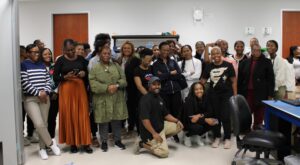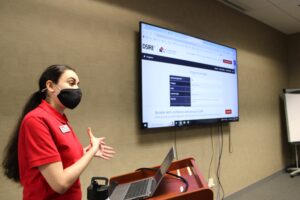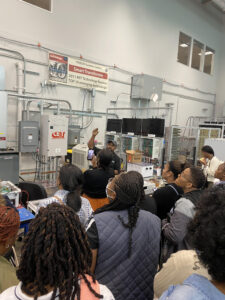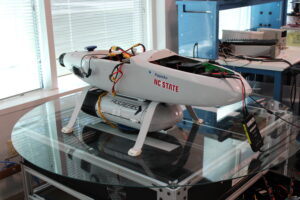Women executives based in South Africa visit NCCETC to learn best practices for expanding renewable energy
On June 7, 2024, NCCETC hosted a group of 35 women executives in the energy sector based in Johannesburg, South Africa. The women are on a several month learning journey that encompasses online courses along with unique in-person experiences that shape best practices for expanding renewable energy in South Africa. The South African Energy & Water Sector Education Training Authority (EWSETA) selected the majority of the professionals from one of the country’s major utility companies, Eskom. A handful of teachers and administrators from a technical institute were also part of the group, along with entrepreneurs who own businesses in South Africa. All of the participants are highly educated and hold positions of influence within their organizations.

One of the main parts of their learning journey brought the women to Duke University to participate in the Duke Corporate Education Global Immersion Program. They studied forms of leadership for several days at the Fuqua School of Business, a non-profit associated with Duke University that develops education programs catered to executives. Dr. Wayne Mayer, Ph.D., founder of a sustainability consulting service When Everything Matters, instructed the class of executives using the Appreciative Inquiry (AI) method. This learning structure encourages a positive approach to problem solving and uses a “4 D process”: Discover, Dream, Design, and Deployment. Dr. Mayer says this process allows problems to be viewed as “mysteries to be uncovered”. “You appreciate what is, appreciate each other, and ask unconditionally positive questions that lead you to co-create the changes you want.”
The first exercise the women participated in was to develop a questionnaire to ask each other what is already beneficial about the energy sector in South Africa. Then, through a lecture by Dr. Deb Wojcik, Ph.D., Executive Director of Research Triangle Cleantech Cluster (RTCC), they began to discover the renewable energy industry in North Carolina, and the benefits it currently offers.
South Africa is in the first stages of decarbonization, as most of their electricity runs on coal fired energy and fossil fuels. The women were asked to “dream” in an exercise in which they try to imagine the future they desire with questions such as: “How do we segway off of coal?” “How can we produce more energy, make it cost effective, and make it so large utility companies can make a profit?” “How can we achieve equitable access to these new technologies?” “If all of these things came true, what would that look like?” Dr. Mayer noted that equitable access is needed in South Africa, as outside of Johannesburg there are areas in which access to energy from any source can be scarce or unreliable. The executives considered how they can invite people from these areas into the low carbon economy by providing the necessary training they need to implement the systems. This would allow these communities to recognize the innovative technologies available and the potential for job opportunities that renewable energy brings.
The third part of the AI model is Design, which in two phases addresses how the desired future can be achieved. The first phase is to brainstorm, in which the class generated numerous ideas of how to introduce renewable energy across South Africa. The second phase is rapid prototyping – involving prioritizing what is tangible, and making a physical prototype of that which can be taken to the market. Dr. Mayer described this as an “iterative process”, where the prototype will be constantly improving as consumers give feedback.
Deployment, the final “D” in the learning process, allows the executives to map out the steps it takes to reach their vision of the future. Dr. Mayer encouraged the class to identify who they might work with within the room, who they could reach out to in larger networks, and to solidify a timeframe to build momentum in their endeavors. Those who are a part of Eskom began to collaborate on topics of energy efficiency and what that looks like within their company. Links were also built between Eskom, those from the technical institute, and the entrepreneurs in the class to discuss how they could benefit each other, in terms of advancing skill levels of employees, and building alliances for energy justice with NGOs and businesses. Professionals in renewable energy finance spoke with the group as well to share their knowledge of incentives that would be viable as well as how to request financing for a project within the energy sector.
The in-class learning experiences were paired with visits to renewable energy organizations around the Triangle. The executives went to SAS and observed their solar grazing farm which helped demonstrate the possibilities for dual land use that can be applied to a large scale. To explore microgrids and the practicality of those technologies, the class visited PowerSecure. They also traveled to FlexGen and explored the potential that battery storage can bring to large solar systems.

The last destination the executives visited was NCCETC and the FREEDM Center on North Carolina State University’s campus. NCCETC Policy Analysts Rebekah de la Mora and Emily Apadula gave a presentation to the group about the Database of State Incentives for Renewables & Efficiency (DSIRE) and how it can be utilized on a national scale. Dr. Mayer said many of the women were “surprised at the scale and size, the amount of data, and the way it was organized”. He noticed that they believe something similar can be done in South Africa as they begin to implement renewable energy, by identifying the areas that are favorable from a policy standpoint.

Following the presentation, Lab Manager Hulgize Kassa gave a tour of the FREEDM Center and allowed the group to see the advancements their engineers are currently making in developing a modern power grid. The tour gave the executives a chance to see what is new in research and how it applies to innovative renewable energy technology. Dr. Mayer says this built off of the finance discussion of the classroom portion of the program, emphasizing the question “What can we do today and what is the value tomorrow, based on what we do today?”

The workings at the FREEDM lab are an example of the latest and greatest clean energy technologies. The visit sparked interest in the executives as they began to consider how to accelerate South Africa’s transition to clean energy as technology continues to advance.